
Ribes triste, known as the northern redcurrant, swamp redcurrant, or wild redcurrant, is an Asian and North American shrub in the gooseberry family. It is widespread across Canada and the northern United States, as well as in eastern Asia.

Lilium canadense, commonly called the Canada lily, wild yellow-lily, or meadow lily, is a native of eastern North America. Its native range extends from Ontario to Nova Scotia south to Georgia and Alabama. It is most common in New England, the Appalachian Mountains, and the Canadian Maritimes. It is also cultivated as an ornamental in Europe and other places.

Grindelia squarrosa, also known as a curly-top gumweed or curlycup gumweed, is a small North American biennial or short-lived perennial plant.
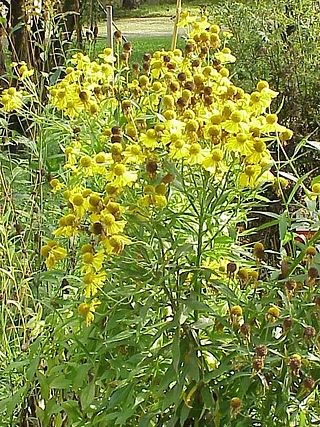
Helenium autumnale is a North American species of poisonous flowering plants in the family Asteraceae. Common names include common sneezeweed and large-flowered sneezeweed.

Ribes aureum, known by the common names golden currant, clove currant, pruterberry and buffalo currant, is a species of flowering plant in the genus Ribes native to North America.

Helianthus grosseserratus, commonly known as sawtooth sunflower or thick-tooth sunflower, is a perennial sunflower in the family Asteraceae, with a large flowering head (inflorescence).

Ageratina herbacea is a North American species of flowering plants in the family Asteraceae known by the common names fragrant snakeroot and Apache snakeroot. It is native to desert regions of the southwestern United States and northern Mexico. It grows in rocky slopes in conifer forests and woodlands.

Allium cratericola is a species of wild onion known by the common name Cascade onion. It is endemic to California, where is an uncommon member of the flora in several of the state's mountain ranges, including the northern and southern California Coast Ranges, the western Transverse Ranges, Klamath Mountains, and the Sierra Nevada foothills. Its range covers much of the state, from Riverside County to Siskiyou County.

Allium parishii is an uncommon species of wild onion known by the common name Parish's onion. It is native to the Mojave Desert and Sonoran Deserts of California and Arizona. It grows on open dry, rocky slopes at elevations of 900–1,400 m (3,000–4,600 ft).
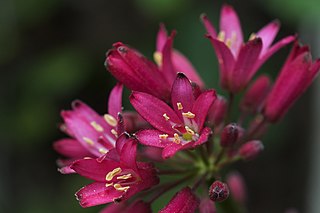
Clintonia andrewsiana is a species of flowering plant in the lily family Liliaceae. The species was discovered by John Milton Bigelow in 1854 and described by John Torrey in 1856. The specific epithet andrewsiana honors Timothy Langdon Andrews (1819–1908), a "gentleman who assiduously examined the botany" of California during the mid-19th century. The species is commonly known as Andrews clintonia or red clintonia, where the latter refers to the color of the flowers. In California, it is also known as bluebead lily or western bluebead lily, not to be confused with C. borealis, which is likewise known as bluebead lily. The Pomo people of northern California consider the plant to be poisonous.

Rhamnus alnifolia is a species of flowering plant in the buckthorn family known by the common names alderleaf buckthorn, or alder buckthorn. Unlike other "buckthorns", this alder buckthorn does not have thorns. It is native to North America, where it is known mainly from the southern half of Canada and the northern half of the United States and California. It can be found in forested habitat.

Eriophorum viridicarinatum is a species of sedge known by the common names thinleaf cottonsedge, green-keeled cottongrass, and bog cottongrass. It is native to Canada and the United States.

Ribes americanum is a North American species of flowering plant in the gooseberry family known as wild black currant, American black currant, and eastern black currant. It is widespread in much of Canada and the northern United States.

Platanthera orbiculata, the round leaved orchid or lesser roundleaved orchid, is a species of orchid native to forested areas of North America. It is widespread across most of Canada and parts of the United States.

Solidago latissimifolia, common name Elliott's goldenrod, is North American species of flowering plants in the family Asteraceae. It is native to the Atlantic Coast of the United States and Canada, from Nova Scotia south to Alabama and Florida.

Solidago uliginosa, or bog goldenrod, is a North American species of flowering plants in the family Asteraceae. It is found in eastern Canada and the eastern United States.
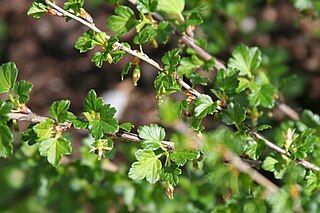
Ribes rotundifolium is a North American species of currant known by the common names wild gooseberry and Appalachian gooseberry. It is native to the eastern United States, primarily the Adirondacks, from Massachusetts and the Appalachian Mountains south as far as South Carolina and Tennessee.
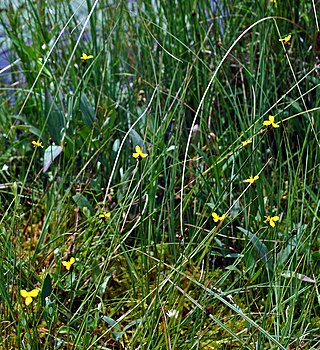
Xyris montana, the northern yelloweyed grass, is a North American species of flowering plants in the yellow-eyed-grass family. It grows in eastern and central Canada and in the northeastern and north-central United States.
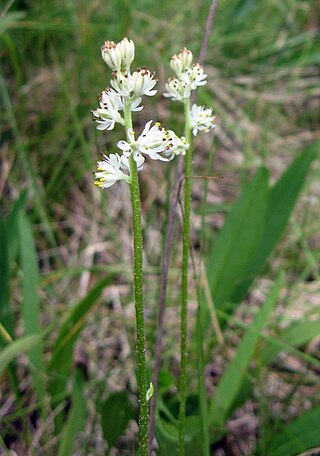
Triantha glutinosa is a species of flowering plant in the Tofieldiaceae family. It is commonly known as the sticky false asphodel, sticky tofieldia or northern bog asphodel, is a species of flowering plant in the tofieldia family.

Viola sagittata, commonly called the arrowleaf violet, is a species of flowering plant in the violet family (Violaceae). It is native to the eastern North America in Canada and the United States, where it is widespread. It is found in a variety of natural habitats, but is most common in dry, open communities such as prairies, glades, or woodlands, often in sandy or rocky soil.





















